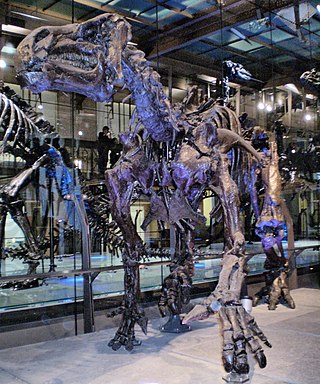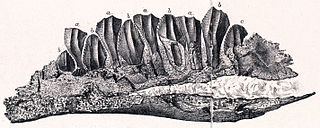
Iguanodon, named in 1825, is a genus of iguanodontian dinosaur. While many species have been classified in the genus Iguanodon, dating from the late Jurassic Period to the early Cretaceous Period of Asia, Europe, and North America, taxonomic revision in the early 21st century has defined Iguanodon to be based on one well-substantiated species: I. bernissartensis, which lived from the late Barremian to the earliest Aptian ages in Belgium, Germany, England, Spain, and possibly elsewhere in Europe, between about 126 and 122 million years ago. Iguanodon was a large, bulky herbivore, measuring up to 9–11 metres (30–36 ft) in length and 4.5 metric tons in body mass. Distinctive features include large thumb spikes, which were possibly used for defense against predators, combined with long prehensile fifth fingers able to forage for food.

Dryosaurus is a genus of an ornithopod dinosaur that lived in the Late Jurassic period. It was an iguanodont. Fossils have been found in the western United States and were first discovered in the late 19th century. Valdosaurus canaliculatus and Dysalotosaurus lettowvorbecki were both formerly considered to represent species of Dryosaurus.

Camptosaurus is a genus of plant-eating, beaked ornithischian dinosaurs of the Late Jurassic period of western North America and possibly also Europe. The name means 'flexible lizard'.
Callovosaurus is a genus of iguanodontian dinosaur known from most of a left thigh bone discovered in Middle Jurassic-age rocks of England. At times, it has been considered dubious or a valid genus of basal iguanodontian, perhaps a dryosaurid.

Cumnoria is a genus of herbivorous iguanodontian dinosaur. It was a basal iguanodontian that lived during the Late Jurassic period in what is now Oxfordshire, United Kingdom.

Zalmoxes is an extinct genus of rhabdodontid ornithopod dinosaur from the Maastrichtian of Romania. The genus is known from specimens first named as the species Mochlodon robustum in 1899 by Franz Nopcsa before being reclassified as Rhabdodon robustum by him in 1915. In 1990 this name was corrected to Rhabdodon robustus by George Olshevsky, and in 2003 the species was once more reclassified, this time as the type species Zalmoxes robustus. Zalmoxes refers to the Dacian deity Zalmoxis, and robustus to the robustness of the remains. In 2003 another species was named, Zalmoxes shqiperorum, named for the Albanian name for Albanians.
Planicoxa is a genus of advanced iguanodontian dinosaur from the Early Cretaceous of North America. It is known from the partial skeletons of several individual specimens. Its fossils were discovered in Utah, United States.

Lurdusaurus is a genus of massive and unusually shaped iguanodont dinosaur from the Elrhaz Formation in Niger. It contains one species, L. arenatus. The formation dates to the Early Cretaceous, roughly 112 million years ago. Lurdusaurus has a highly atypical body plan for an iguanodont, with a small skull, long neck, rotund torso, and powerful forelimbs and claws, somewhat reminiscent of a ground sloth. Its metacarpals are fused and reinforced into a large block, and the thumb spike is remarkably enormous. These would have allowed the hand to have functioned almost like a ball-and-chain flail. Lurdusaurus is estimated to have been 7–9 m (23–30 ft) long and 2 m high when on all-fours, but its stomach would have been only 70 cm off the ground. It may have weighed 2.5–5.5 t, conspicuously heavy for an iguanodontid this size.

Dryosaurids were primitive iguanodonts. They are known from Middle Jurassic to Early Cretaceous rocks of Africa, Europe, and North America.
The Lakota Formation is a sequence of rocks of early Cretaceous age from Western North America. Located in South Dakota, the name of the formation is derived from the Lakota Native American tribe.

Dakotadon is a genus of iguanodont dinosaur from the Barremian-age Lower Cretaceous Lakota Formation of South Dakota, USA, known from a partial skull. It was first described in 1989 as Iguanodon lakotaensis, by David B. Weishampel and Philip R. Bjork. Its assignment has been controversial. Some researchers suggest that "I." lakotaensis was more basal than I. bernissartensis, and related to Theiophytalia, but David Norman has suggested that it was a synonym of I. bernissartensis. Gregory S. Paul, working on a revision of iguanodont species, gave "I." lakotaensis its own genus (Dakotadon) in 2008. He measured its length at 6 metres (20 ft) and body mass at 1 metric ton.

Owenodon is a genus of iguanodontian dinosaur known from a partial lower jaw discovered in Early Cretaceous-age rocks of Durlston Bay, Dorset, United Kingdom. The specimen, NHM R2998, comes from the Purbeck Limestone, dating to the middle Berriasian stage. It was first described by Richard Owen, who in 1874 assigned it to Iguanodon as the type specimen of the new species I. hoggii, the specific name honouring naturalist A.J. Hogg who had originally collected the fossil in 1860. The bone was damaged during initial preparation but was freed from the surrounding rock matrix by an acid bath between 1975 and 1977. David Norman and Paul Barrett subsequently transferred the species to Camptosaurus in 2002, but this was challenged, and in 2009 Peter Galton assigned the species to the new genus Owenodon, meaning "Owen's tooth", named after Sir Richard Owen. Galton interpreted the genus as an iguanodontoid more derived than Camptosaurus but less derived than Lurdusaurus.

Barilium is a genus of iguanodontian dinosaur which was first described as a species of Iguanodon by Richard Lydekker in 1888, the specific epithet honouring the discoverer Charles Dawson.

Hippodraco is a genus of iguanodontian ornithopod dinosaur from the Early Cretaceous Cedar Mountain Formation of Utah, United States. The genus contains a single species, H. scutodens, known from a partial skeleton belonging to an immature individual.

Iguanacolossus is a genus of iguanodontian ornithopod dinosaur that lived in North America during the Early Cretaceous period. It is known from UMNH VP 20205, the associated holotype with a large partial skeleton of a single individual.

Uteodon is a genus of herbivorous iguanodontian dinosaur. It is a basal iguanodontian which lived during the late Jurassic period in what is now Uintah County, Utah. It is known from the middle of the Brushy Basin Member, Morrison Formation. The genus was named by Andrew T. McDonald in 2011 and the type species is U. aphanoecetes. it has also been reported from portugal.
Osmakasaurus is a genus of herbivorous iguanodontian dinosaur. It is a basal iguanodontian which lived during the Early Cretaceous period in what is now Buffalo Gap of South Dakota, United States. It is known from the Chilson Member of the Lakota Formation. This genus was named by Andrew T. McDonald in 2011 and the type species is O. depressus.

Ankylopollexia is an extinct clade of ornithischian dinosaurs that lived from the Late Jurassic to the Late Cretaceous. It is a derived clade of iguanodontian ornithopods and contains the subgroup Styracosterna. The name stems from the Greek word, “ankylos”, mistakenly taken to mean stiff, fused, and the Latin word, “pollex”, meaning thumb. Originally described in 1986 by Sereno, a most likely synapomorphic feature of a conical thumb spine defines the clade.























